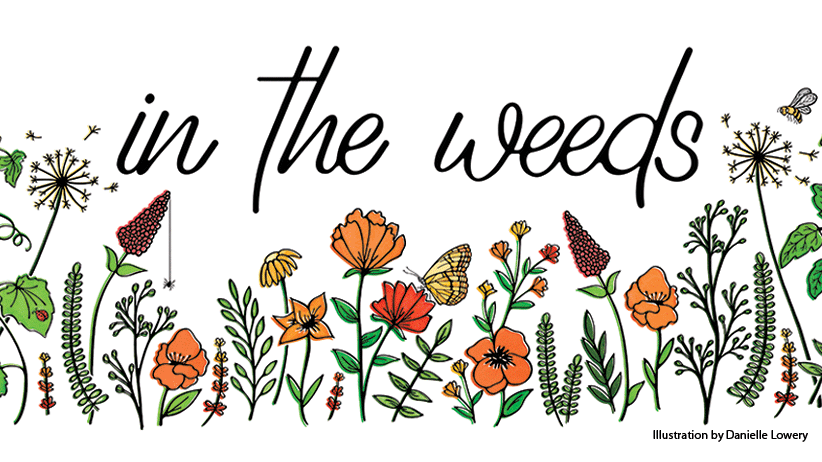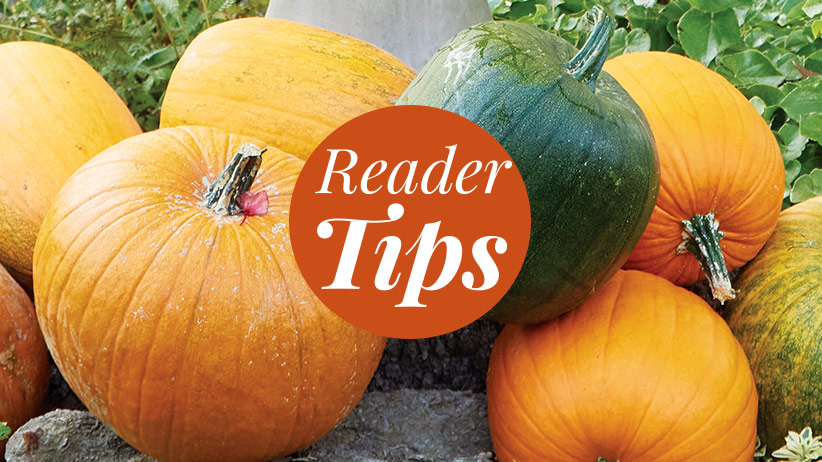
A garden full of stories
Knock on the front door of Jim and Rachel Light’s Ohio home and you probably won’t get an answer — they’ll be in the garden! But wander around to the back door above and you’ll find Rachel nearby pulling weeds or swapping out her seasonal displays and Jim working on his latest construction project. This industrious couple has been gardening here for all 49 years of their marriage, and they have no plans to slow down. The 4½-acre property is where Rachel spent her childhood and she’s seen lots of changes. Her parents grew vegetables and a few flowers, but she and Jim have transformed the yard around the home into a shady oasis.
Jim built a new home a few years into their marriage after they discovered that the original house had serious termite damage. Once that was finished, the couple has continued to add new gardens and structures every year. Let’s see what they’ve done.

Garden transformation
The very first garden bed was a Mother’s Day present for Rachel in 1982. She wanted a pleasant view from her bedroom window, so Jim and their boys used a garden hose to lay out a 6-foot-diameter island bed. The following year she asked Jim to make it a little bigger. The next year she asked the same thing. Now it’s the 22-foot-long kidney-shaped island bed above. With a family to raise, Jim and Rachel had to be budget-minded, so they started with small beds and added to them as time and money allowed.
Now they have plenty of room to grow the plants they love. They’ve stuck with their money-saving strategies over the years and often barter to achieve their horticultural goals. For example, Rachel used to drive a school bus. Between her morning and afternoon shifts, she worked for a hosta grower, who paid her in plants. And Jim recently traded labor and his own cuttings for five large deciduous trees from a local tree grower.

Recycled stone wall
Fond memories of playing on a stone wall with his cousins at his grandfather’s home inspired Jim to build this 13½-foot-long structure, where his own kids and grandkids played. Now Rachel sets containers and seasonal decor there. The low walls stairstep from 3 feet tall to 4 feet close to the entry arch, creating a transition from the driveway and gazebo area to the house. Jim was inspired to build the impressive 9-foot-tall arch when he had bricks left over from the home's construction.

Grow better flower borders
Each time a new bed goes in, Jim digs out 4 to 6 inches of heavy clay soil by hand. He replaces it with equal parts topsoil and compost, which sets new plants up for growing success. In addition, Rachel finds that the loose mix makes pulling weeds a lot easier.
The most difficult implementation of this technique was this expansive 200-foot-long and 4- to 5-foot-wide border along the driveway above. Now that it’s filled with panicle hydrangeas (Hydrangea paniculata), dahlias (Dahlia hybrid) and a dwarf hinoki cypress (Chamaecyparis obtusa), the extra work seems worth it.
You Might Also Like:
Our Favorite Panicle Hydrangeas
Watch Our Talk & Tour Garden Videos
Garden Plans for Sun & Shade

5 ways to make fabulous fall garden displays
Jim and Rachel’s borders boast plenty of color and interest in every season, and containers play a key role. Ceramic pots, elegant urns, classic windowboxes and upcycled treasures — they’re all fair game. Most are filled with annuals and decked out seasonally. But others hold perennials, such as coral bells (Heuchera spp. and hybrids) and hostas, which overwinter in place. While Rachel loves being in the garden all year, fall is her favorite season. As summer fades she decorates inside and out using pumpkins and garden mums. In fact, sometimes she’ll buy a whole pickup load of pumpkins! Check out a few of Rachel’s tips and creations above.
1. Upcycle containers
Rachel saves money by planting in upcycled items they find around the yard or at flea markets. Iron kettles, wash tubs, an old hog feeder and a hollow log are some of the things she’s planted up. The old wheelbarrow above overflowing with wing begonias (Begonia hybrid) is a favorite piece.
2. Make garden mums a focal point
Fall and garden mums (Chrysanthemum hybrid) go hand in hand. Rachel has them all over the garden. The concrete pedestal above used to support a birdbath but now it elevates an elegant planter filled with red-flowering mums.
3. Add a pumpkin!
Have a hole in a planting that's otherwise still going strong? Tuck in a pumpkin!

4. Seasonal DIY Decor
Rachel saw a potting bench like this one in a magazine and asked a neighbor to build it. Last fall she cut handfuls of hydrangea blooms and wired them together to create an 8-foot-long garland that lasted well into winter.
5. Create a pumpkin topiary
To make her pumpkin topiary, Rachel holds “auditions” to see which ones stack best. Stabilizing the stack with rods would just cause the pumpkin to rot. They sit on a 20-inch pizza pan covered with artificial leaves.
You Might Also Like:
Upcycled Project Ideas
Potting Bench Woodworking Plan
Watch Our Garden Project Playlist on YouTube

Gardening in shade
Rachel and Jim use the back door more than the front — it’s closer to the shady sidewalk that leads to the driveway. Beds along this path are filled with a variety of shade plants. Hostas and ferns are some of Rachel’s favorites. To grow big, healthy hostas (Hosta spp. and hybrids), she follows some advice that she learned from a local grower years ago: Sprinkle high-nitrogen fertilizer around plants when they’re dormant in February. That way you don’t have to worry about burning the leaves with plant food.
The garden is filled with hardy ferns, such as Japanese painted ferns (Athyrium niponicum var. pictum), tassel fern (Polystichum polyblepharum) and maidenhair fern (Adiantum spp.), in the borders. Plus Rachel grows Boston ferns (Nephrolepis exaltata) in containers and overwinters them from year to year indoors.
Growing trees means more shade
The property hosts nearly 170 trees, and many have stories associated with them. For example, in the 1960s, the owner of a nearby apple orchard gave Rachel’s mother two pecan nuts and instructed her to put them in a coffee can filled with soil in the freezer over the winter. When she pulled them out the following spring, they sprouted, and she eventually planted them. They’re still here, and the one above is now 100 feet tall with a trunk 3 feet in diameter. Every few years Rachel and Jim get a bumper crop of pecans — last year they saved 42 quarts of shelled nuts and gave away gallons of unshelled ones.
Planting near trees
In Rachel’s experience, planting near trees with shallow roots presents the biggest challenge to a shade garden. Pine (Pinus spp. and hybrids) and red maple (Acer rubrum) form the densest mats but over time, they’ve lost many of them to old age. When it comes to replacements, they look for trees that send most of the roots deeper, such as black gum (Nyssa sylvatica), and smaller understory types, such as redbuds (Cercis spp. and hybrids). However, the big old Eastern hemlock (Tsuga canadensis) behind the house has roots peeking above the soil’s surface. It’s difficult to compete with that behemoth, but a ground cover of epimedium (Epimedium spp. and hybrids) is up to the task, even spreading in this tough spot.

Go-to shade plants
Here are a few of Rachel’s favorite shade plants and why she likes them. Some bring back memories of family and friends.
-
Brunnera (Brunnera macrophylla)
Airy, pale blue spring flowers top mounds of bristly green or variegated foliage on plants that grow 12 to 18 inches tall, 18 to 24 inches wide in USDA zones 3 to 9.
“It’s hard to find this color in flowers.” -
Dutchman’s breeches (Dicentra cucullaria)
Ferny foliage topped by winged blooms look like an upside-down pair of pants. Plants grow 6 to 12 inches tall and wide in USDA zones 3 to 7.
“Such a dainty little plant, and it always makes me think of Aunt Margie.” -
European wild ginger (Asarum europaeum)
Mounds of glossy dark green leaves grow 4 to 8 inches tall and 9 to 12 inches wide in USDA zones 4 to 8.
“I love the small glossy leaves, and you have to lift up the leaves to see the flowers.” -
Hakonechloa (Hakonechloa macra ‘Aureola’)
Graceful yellow-and-green-striped leaves form an arching mound that grows 12 to 18 inches tall and 6 to 12 inches wide. Plants are cold hardy in USDA zones 3 to 9.
"The chartreuse color and billowy effect of the foliage is magnificent for a grass in shade." -
Jack-in-the-pulpit (Arisaema triphyllum)
Long stems form a spathe (the pulpit) and a hooded spadix (Jack). Plants grow 12 to 36 inches tall and 12 to 28 inches wide in USDA zones 4 to 9.
“It always makes me think of my mom. As children we’d cross the road and go hunting for them in the woods.” -
Trillium (Trillium sessile)
Stems are topped by three variegated leaves with three erect maroon to brown petals in the center. Plants grow 6 to 12 inches tall and wide in USDA zones 4 to 8.
“I got some plants from my son, and they love to reseed.”
You Might Also Like:
Showy Shade Garden Ideas
Stroll Through a Southern Shade Garden
Garden Gate's Favorite Hostas

DIY projects and garden structures
Over the years, Rachel and Jim added several buildings that bring charm and structure to the garden. Follow the stone path from the back door, and you’ll arrive at Rachel’s sewing shed (above). It’s her crafty getaway where she spends time creating quilts and other projects. Plus, there's enough room to store some of her seasonal decor too.

Garden gazebo
Jim built the gazebo above over an old stone-lined well. The hand pump still works, so they use it to draw water for plants in the garden. This shady spot sits right next to the driveway and is a great place to sit and relax or duck in out of the rain when you get out of the car.

DIY Greenhouse
In addition to the other buildings on the property, Jim built this 10×20-foot greenhouse from scrap lumber and patio doors that had lost their seals. His research told him that for maximum sun exposure at their longitude, the greenhouse’s windows needed to face 17 degrees east of due south. So he used a compass and 4-foot-long level to mark the spot before he started building.
A 75-gallon rain barrel supplies water for the greenhouse. Jim can check the battery-operated thermometer from his living room to make sure the interior stays 60 to 65 degrees F. If the temps rise too much, he’ll walk over there to open a window. If it gets too cold, a ceramic space heater automatically switches on.
Helpful garden structures
Jim and Rachel always hit the garden centers early in the year, but now they don’t have to worry about what to do with those purchases that aren’t ready to face the cool spring nights when they get home. In addition to the greenhouse, they also have a hoop house, where they store these plants and harden off seedlings. One year Jim counted 20 hanging baskets waiting for warmer days there. Every year is a new adventure in this always-evolving garden!
You Might Also Like:
Gazebo Woodworking Project Plan
See More Feature Gardens
DIY Rain Barrel















